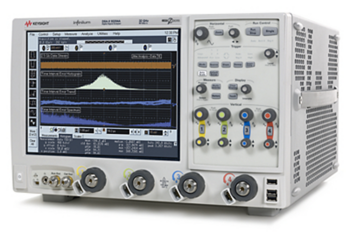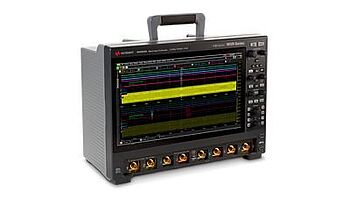This article is brought to you by the Keysight Used Equipment Store. The information applies to used and new equipment.
If you know which Keysight model is of interest to you and matches your technical requirements, visit the Used Equipment Store to see if you can save with our offers.
View Our Offers
For more Test and Measurement knowledge and tips, view all technical articles. Visit our resources
Keysight assumes no liability for the completeness, correctness and accuracy of all content on this website and all of its content. Please read here the terms of use of this website.
Article Feedback
Give us any feedback you might have about this article.
- Introduction
- Operating Principle
- Main Components of a Band-Stop Filter
- Types of Band-Stop Filters
- Passive Band-Stop Filters
- Active Band-Stop Filters
- Key Parameters of a Band-Stop Filter
- Applications of Band-Stop Filters
- Theoretical Foundations of Band-Stop Filters
- Fourier Analysis
- Frequency Domain and Time Domain
- Transfer Function
- Q-Factor and Resonance
- Conclusion
- Keysight Oscilloscopes
- Whenever You’re Ready, Here Are 4 Ways We Can Help You
For electrical engineers, signal analysts, and technicians working with oscilloscopes, manipulating and analyzing signal frequencies is an everyday task. The complexity of electronic systems often hinges on their capacity to manipulate and control frequencies. In this intricate web of signals and spectrums, one device stands out for its efficiency and versatility – the band-stop filter.
A band-stop filter, also known as a "band reject" or "notch" filter, is a filter that attenuates a specific band of frequencies in a signal's frequency spectrum. It allows the frequencies below and above the stopband (rejected band) to pass through almost unaltered.
Buy Oscilloscopes at a Great Discount
- Like-new Condition
- Updated Firmware
- Full Calibration
- New Accessories
- Like-new Warranty
- Customization possible
- Savings of up to 90%
- Working Condition
- Calibrated or Tested
- 30-Day Right-of-Return
- No Customization
- Shipping to limited countries
Operating Principle
The operating principle of a band-stop filter is quite simple. It aims to eliminate or substantially reduce a particular band of frequencies in a signal, hence the name "band-stop". The band stop filter passes higher and lower frequencies unaltered while blocking the frequencies within a certain range, known as the "stop band".
| Key Takeaway |
|---|
Band-stop filters, with their ability to precisely eliminate specific frequency bands, are essential in signal processing and electronic design. Understanding their operational principles, types, and applications can significantly enhance the performance and efficiency of various electronic systems. |
Main Components of a Band-Stop Filter
A typical band-stop filter is composed of the following elements:
- High-pass filter: Allows frequencies higher than a certain value to pass.
- Low-pass filter: Allows frequencies lower than a certain value to pass.
- Summing Amplifier: Combines the analog outputs of the high and low pass filters.
Types of Band-Stop Filters
There are two commonly used band-stop filters: Passive band stop filters and active band stop filters.
Passive Band-Stop Filters
A passive band-stop filter comprises passive components like resistors, capacitors, and inductors. It doesn't require an external power source. Passive band stop filters are easy to design and implement but may lack the preciseness and sharpness of rejection found in active filters.
Active Band-Stop Filters
Active band-stop filters require an external power source and include active components like transistors and operational amplifiers, and passive components. These filters provide better performance and precision than passive ones, especially for narrower stop bands. However, they are more complex and costly to design and implement.

Key Parameters of a Band-Stop Filter
Band-stop filters are characterized by the following parameters:
- Stop band: The range of frequencies that the filter attenuates.
- Pass band: The frequencies that are allowed to pass with minimal attenuation.
- Bandwidth: The range of frequencies within the stop band.
- Center Frequency (f0): The stop band's midpoint frequency that is attenuated the most.
- Q-factor: The ratio of the center frequency to the bandwidth. It determines the 'sharpness' of the rejection band.
The following table shows an example of these parameters for a hypothetical band-stop filter.
| Parameter | Value |
| Stop band | 10 kHz – 20 kHz |
| Pass band | < 10 kHz, > 20 kHz |
| Bandwidth | 10 kHz |
| Center Frequency (f0) | 15 kHz |
| Q factor | 1.5 |

Applications of Band-Stop Filters
Band-stop filters have a wide range of applications, including:
- Noise Reduction: They are used to eliminate unwanted frequencies or noise from a signal.
- Signal Processing: In signal processing and communication systems, band-stop filters are used to prevent specific frequency bands from interfering with the signal.
- Audio and Video Processing: They are used to remove certain sounds (frequencies) from audio tracks or remove specific color tones (frequencies) from video signals.
- RF Applications: In RF circuits, band-stop filters are used to block certain frequency bands to avoid interference with other frequency bands.
Theoretical Foundations of Band-Stop Filters
A deeper understanding of band-stop filters requires delving into the underlying theoretical foundations firmly rooted in Fourier analysis and signal processing in the frequency domain.
Fourier Analysis
Fourier Analysis is a mathematical method used for decomposing a signal into its constituent frequencies. Every complex signal can be represented as a sum of simple sine and cosine waves of different frequencies. This spectral decomposition is fundamental to understanding the operation of band-stop filters, which attenuate or eliminate specific frequency components from a signal.
Frequency Domain and Time Domain
In signal processing, two domains are commonly referred to – time and frequency. The time domain represents how a signal changes over time, while the frequency domain represents the signal in terms of its frequency components. A band-stop filter's operation is most clearly understood in the frequency domain: it allows frequencies below and above a certain range (the stop band) to pass while attenuating the frequencies within that range.
Transfer Function
The behavior of a band-stop filter is represented mathematically by its transfer function, H(f), which defines the relationship between the input and output of the filter. For a band-stop filter, this function will exhibit low values (ideally zero) for frequencies within the stop band and high values (ideally one) for frequencies outside the stop band.
Q-Factor and Resonance
The Q-factor, or quality factor, of a band-stop filter is a measure of how "sharp" or "narrow" the stop band is. A high Q-factor means a narrower stop band and vice versa. This is intimately linked with the concept of resonance in electrical circuits, where certain frequencies are naturally amplified. In a band-stop filter, the aim is to achieve 'anti-resonance' at the undesired frequencies.
Understanding these theoretical principles provides a more comprehensive perspective on band-stop filters, enhancing both the effectiveness of their use and the efficiency of their design.
Conclusion
Band-stop filters, with their frequency-manipulating capabilities, hold significant value in the realm of electronics, particularly in signal processing and communication systems. They allow engineers to exert surgical precision on frequency spectrums, eliminating undesirable components while leaving the rest unaltered. Their applications range from noise reduction to audio and video processing and RF circuits, underlining their widespread utility.
In essence, a comprehensive understanding of band-stop filters and their implementation not only elevates the quality of your work but also broadens the scope of possibilities in electronic design and signal processing. Embracing the power of band-stop filters is an essential step towards mastering the intricacies of electronic engineering.
Keysight Oscilloscopes
Buying a used oscilloscope is the best way to save money without sacrificing quality. You can save up to 90% when purchasing from Keysight Technologies!
We offer a wide range of high-quality, premium, refurbished oscilloscopes backed by a 1-year warranty. Check out our premium Used Equipment page to choose a premium refurbished oscilloscope with some of the highest standards and specifications in the industry.

Browse Oscilloscopes at a Great Discount
- Like-new Condition
- Updated Firmware
- Full Calibration
- New Accessories
- Like-new Warranty
- Customization possible
- Savings of up to 90%
- Working Condition
- Calibrated or Tested
- 30-Day Right-of-Return
- No Customization
- Shipping to limited countries
Whenever You’re Ready, Here Are 4 Ways We Can Help You
- Browse our Premium Used Equipment.
- Call tech support US: +1 800 829-4444
Press #, then 2. Hours: 7 am – 5 pm MT, Mon– Fri - Talk to our sales support team by clicking the icon (bottom right corner) on every offer page
- Talk to your account manager about your specific needs
This article is brought to you by the Keysight Used Equipment Store. The information applies to used and new equipment.
If you know which Keysight model is of interest to you and matches your technical requirements, visit the Used Equipment Store to see if you can save with our offers.
View Our Offers
For more Test and Measurement knowledge and tips, view all technical articles. Visit our resources
Keysight assumes no liability for the completeness, correctness and accuracy of all content on this website and all of its content. Please read here the terms of use of this website.

































































































